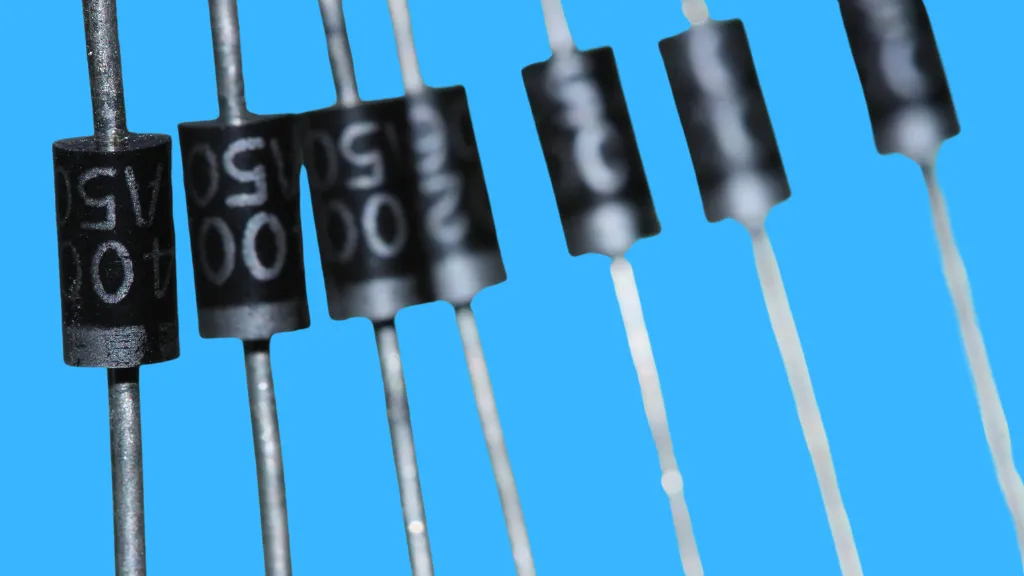What is a Schottky Diode?
You might wonder, “What exactly is a Schottky diode?” It’s a special semiconductor device with unique features that make it super important in modern electronics.
In this article, we will explore what Schottky diodes are, how they work, and why they are so important. Whether you’re a tech enthusiast, an engineering student, or just curious about electronics, there is something fascinating about these components.
So, let’s get started and uncover the world of Schottky diodes!
Basic Principles of Schottky Diodes
Schottky diodes are made from a combination of a metal and a semiconductor material, typically N-type silicon. This combo sets them apart from regular diodes, which usually involve a junction between P-type and N-type semiconductor materials.
The metal side of a Schottky diode might be something like platinum, gold, or tungsten – metals that mean business in conducting electricity.
Now, the key characteristics of Schottky diodes make them valuable. One of the big ones is their low-forward voltage drop. In simpler terms, they don’t need a lot of voltage to start conducting electricity.
This is great because they’re more efficient and waste less power. Imagine it like a door that’s easier to open – it doesn’t take much effort to get the current flowing.

Another cool feature is their high switching speed. Schottky diodes can turn on and off quickly. This is super important in applications that switch currents rapidly, like power supplies or radio frequency applications.
It’s like having a fast light switch that can flick on and off, which is pretty handy.
But there’s a trade-off. These diodes have what’s called leakage current in reverse bias. It means when they’re supposed to block current, they let a little bit sneak through. It’s not ideal, but it’s a small price to pay for the other benefits they offer.
Working Mechanism of Schottky Diodes
The heart of a Schottky diode is something called the Schottky barrier. This junction is formed between a semiconductor material, usually silicon, and a metal, like aluminum or platinum.
This combo sets Schottky diodes apart from regular diodes, which usually have a junction between two types of semiconductor materials.
Now, when we talk about diodes, we often mention two states: forward bias and reverse bias. In forward bias, when applying a voltage across the diode in a specific direction, the Schottky diode allows current to flow through easily.
The metal-semiconductor junction has a lower barrier for electrons to jump over than regular diodes. It’s like having a lower hurdle to leap over – it’s easier.
On the flip side, in reverse bias, the Schottky diode blocks the current when the voltage is applied in the opposite direction. However, it’s not a perfect blocker.
A tiny bit of current, known as leakage current, does sneak through. This is like a small leak in a dam – not enough to cause a flood, but it’s there.
The real magic of Schottky diodes is in their speed. These diodes are like the sprinters of the semiconductor world.
They can switch on and off incredibly fast. This is important in applications requiring rapid switching, like power supplies or radio frequency applications.
Advantages and Limitations of Schottky Diodes
Advantages
Let’s start with the good stuff – the advantages. Schottky diodes are pretty amazing in certain aspects:
- Efficiency in High-Frequency Applications: One of the coolest things about Schottky diodes is how they excel in high-frequency scenarios. They switch on and off super quickly, making them ideal for circuits that need to operate rapidly. It’s like having a fast and efficient sports car in the world of diodes.
- Minimal Power Loss: These diodes are like the energy-saving bulbs of the diode world. They have a lower forward voltage drop compared to regular diodes. This means less energy is wasted as heat, making them more efficient. It’s like they do more but use less energy – pretty neat, right?
- Compact Size: In today’s world, where everything is about being smaller and more compact, Schottky diodes fit right in. They’re typically smaller than traditional diodes, which is great for modern electronic devices that need to pack a lot of functionality into a tiny space.
Limitations
Now, let’s talk about the not-so-great parts. Even superheroes have their weaknesses, and Schottky diodes are no exception:
- Voltage Tolerance: Here’s the thing – Schottky diodes aren’t the best when handling high voltages. They tend to have a lower breakdown voltage, so they might not be the best choice for applications involving high voltage levels. They’re great sprinters but not so good for the marathon.
- Sensitivity to High Temperatures: These diodes can be sensitive to heat. If things get too hot, their performance can take a hit, and nobody wants that. It’s important to keep them cool, like ensuring your phone doesn’t overheat.
- Reverse Leakage Current: This is a bit of a downside. Schottky diodes tend to have a higher reverse leakage current, especially as the temperature increases. They might let some current slip through even when they’re not supposed to. It’s not a deal-breaker but something to remember, especially in precision applications.
What is a Schottky Diode Used For?
- Power Rectification: This is probably one of the most common uses of Schottky diodes. They’re great at converting alternating current (AC) into direct current (DC). You know, like in power supplies for your laptop or other gadgets. They’re so good at this because they have a low forward voltage drop, which means they’re more efficient and generate less heat than regular diodes.
- RF (Radio Frequency) Applications: Schottky diodes are a big deal in radio frequency applications. They’re used in detectors and mixers, essential parts of radio receivers. Their high-speed switching ability makes them perfect for these applications. They can keep up with the super-fast changes in radio signals without breaking a sweat.
- Voltage Clamping and Surge Protection: These diodes are also used to protect circuits from voltage spikes. You know how sometimes there’s a sudden surge of electricity, like during a lightning storm? Schottky diodes can help protect sensitive electronic equipment from getting fried by these surges. They act like a shield, clamping down on the excess voltage.
- Solar Panels and Photovoltaic Cells: Schottky diodes prevent the reverse flow of current in solar panels. They ensure that the electricity generated by the solar panel goes in the right direction (towards your appliances or battery) and doesn’t flow back into the panel, which can cause damage or reduce efficiency.

- Use in Integrated Circuits: These diodes are also found in integrated circuits. Because of their small size and high efficiency, they’re perfect for use in compact electronic devices. They help manage power and protect against voltage irregularities within these tiny circuits.
Recent Developments and Future Trends of Schottky Diodes
Innovations in Materials and Design
One of the most exciting development areas has been the materials used to create Schottky diodes. Traditionally, these diodes have been made using silicon, but recent research has shown promising results with materials like gallium nitride (GaN) and silicon carbide (SiC).
These materials have opened up new possibilities, especially in handling higher voltages and temperatures, a game-changer for power electronics. It’s like we’re pushing the boundaries of what these tiny components can handle, and it’s pretty thrilling to think about the potential applications.
Emerging Applications in Renewable Energy and Electronics
The role of Schottky diodes in renewable energy has been exciting to me. As we move towards more sustainable energy sources, the efficiency of solar panels and wind turbines becomes increasingly important.
With their low forward voltage drop and high efficiency, Schottky diodes are becoming crucial in these applications. They’re helping to minimize energy loss in solar inverters and power converters, making renewable energy systems more efficient and reliable.
These little components play a big part in our journey towards a greener future.
In the electronics world, the high switching speed of Schottky diodes is being leveraged in advanced communication systems, especially in high-frequency applications. We’re talking about faster and more efficient ways to transmit data, essential in our data-driven world.
It’s amazing to think that these diodes are helping us stay connected in more efficient ways.
Future Prospects in Semiconductor Technology
Looking ahead, the potential for Schottky diodes in semiconductor technology seems boundless. We’ll see these diodes becoming even more efficient and versatile with ongoing research and development.
There’s talk about integrating them into more complex integrated circuits and possibly developing new types of diodes that could revolutionize how we think about power management and signal processing.
The future of Schottky diodes is not just about making them smaller or more efficient; it’s about reimagining their role in the broader context of electronic innovation. As we continue to push the limits of technology, I’m excited to see how these diodes will evolve and help shape the future of electronics.
It’s a fascinating time to be involved in this field, and I can’t wait to see what’s next for Schottky diodes.
Conclusion
Throughout this exploration, we’ve seen how the Schottky diode stands out from its conventional counterparts, especially with its low-forward voltage drop and high-speed switching capabilities. These features make it an invaluable player in high-frequency applications and power rectification.
It’s like finding a sports car that’s not only fast but also incredibly efficient – a rare combination in the world of electronics!
Looking ahead, the future seems bright for Schottky diodes. With ongoing advancements in materials and design, who knows what new applications will emerge? From renewable energy to more efficient electronic devices, the potential is enormous.

Author
Alex Klein is an electrical engineer with more than 15 years of expertise. He is the host of the Electro University YouTube channel, which has thousands of subscribers.
